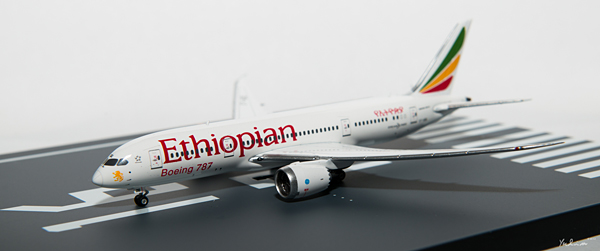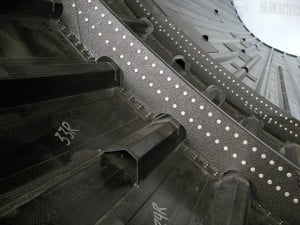Boeing’s Plastic Planes
How Boeing’s adoption of defense-contracting practices led to the flawed Dreamliner 787
The Boeing Corporation’s strategy of saying as little as possible about the spontaneous combustion of one of its “Dreamliner” 787s while the plane was parked at Heathrow Airport on July 12 appears to have had the desired effect on the company’s stock price, which is recovering nicely from an initial post-fire plunge. The incident evoked nasty memories of last January’s overheating Dreamliner batteries, one of which caught fire, leading the entire fleet to be grounded worldwide for four months. And these were only the most serious of the problems that have surfaced since the long-range $206 million jetliner entered service in 2011.
Boeing’s management would clearly like for the Heathrow incident to fade quickly from the news, and for no one to start asking serious questions about the fundamental design concepts built into this revolutionary airliner, or about who thought them up and why. The company may get what it wants, which would be a pity, because this airplane and its faults have much to tell us about the corrupting influence of the military-industrial complex on a once-great company, and on American manufacturing in general.
To understand why Dreamliners catch fire, we must look all the way back to the immediate aftermath of the Cold War, when major defense contractors were facing the prospect of declining defense budgets and consequent diminishing profits. In response, William Perry, newly installed as Deputy Secretary of Defense in the Clinton Administration, presided over a series of mergers between the big firms, which produced an industry dominated by five giant “primes.” Perry offered handsome subsidies to the firms as encouragement to merge, promoting the initiative as beneficial to the taxpayer because it would cut down on wasteful overhead. Needless to say there were no such savings for taxpayers, and the resultant corporate oligopoly inevitably led to increased weapons costs.
One of the mergers united Boeing, the world’s pre-eminent commercial-airliner manufacturer, with McDonnell Douglas, a pure defense company. Boeing was of course also a defense contractor, but top management had traditionally kept the civil and defense divisions separate for fear that the defense team might infect the civilians with their culture of cost overruns, schedule slippage, and risky or unfeasible technical initiatives. These habits were all very well when the taxpayer was footing the bill for cost-plus contracts that might or might not result in a useful product, but they could obviously have proved disastrous when it came to competing with the company’s own money in a free-enterprise market.
Following the merger, however, McDonnell Douglas alumnae — most importantly CEO Henry Stonecipher — emerged in command of the combined company. Among the practices that arrived with Stonecipher and his colleagues from St. Louis was extensive outsourcing. The defense industry loves to outsource the manufacture of minor and major components to outside companies, because such dispersal buys it support in Congress — a practice known as “political engineering.” Parts for the Lockheed Martin F-35, for example, are supplied from across forty-five states, thereby cementing the fealty of ninety U.S. senators to a disastrous (as in years late, vastly over budget, and technically deficient) project. Of course outsourcing drives up costs in a variety of ways, for example by requiring the transportation of components to the ultimate manufacturer for final assembly. It also ensures delays, quality-control problems, and serious safety consequences, given the complexity of assembling parts produced under different management hundreds or thousands of miles apart. As Boeing’s pre-merger management might have predicted, the practice has had serious consequences for the company’s commercial enterprise.
The new team at Boeing also had an additional incentive to outsource: an accounting yardstick beloved of Wall Street analysts, called Return On Net Assets, or RONA. By having subcontractors put up a major portion of the capital required to develop the 787, Boeing could invest less — and when a company reduces the amount of capital it invests, it increases the percentage of return on its investment. Wall Street approved, Boeing’s stock price rose, and the value of its executives’ stock options rose along with it. Thus it was that the first major Boeing airliner initiative under the merged regime, the 787 Dreamliner, was outsourced to an unprecedented degree, with foreseeable effects on schedule (the plane entered service three years late) and cost (it exceeded an initial development estimate of $5 billion by at least $12 billion — an impressive overrun, even by defense standards).
Having adopted one salient feature of defense manufacturing for the 787, the merged company management lunged for another: risky technological initiatives. A primary Dreamliner selling point is its 20 percent savings on fuel compared with the plane it replaces, the 767. Since today’s jet engines burn fuel at more or less the same rate, efficiency depends on reducing the weight of the plane, and “composite materials” (i.e., plastic) are an increasingly popular means to this end. Even though plastic has yet to achieve the same predictability and reliability as metal, the Dreamliner team opted to make greater use of plastic than ever before in an airliner, even employing it for the load-bearing joint that connects the wings to the fuselage, which bears more stress than any other part of the plane. Sure enough, in final static tests, the wing failed and had to be stiffened, at great cost. Boeing’s risky choice prompted one aerospace structural engineer to remark, “Friends don’t let friends fly in plastic airplanes.”
Boeing’s other major weight-reduction initiative was to make the 787 an “all-electric” airplane, which meant that rather than having hydraulic motors drive control surfaces on the wings and tail, along with other components, they would be controlled by large generators backed up by powerful batteries — the lighter the better. Lithium-ion batteries are indeed extremely powerful for their weight, but they are also extremely dangerous, as lithium is notorious for burning with an intense, unquenchable heat. Model-airplane enthusiasts have learned the wisdom of keeping their lithium batteries in an asbestos box when recharging them; too many have seen homes and garages go up in smoke. Nevertheless, that was the route Boeing took. The overheating batteries that prompted the global grounding back in January were a harsh reminder of the risk this choice entailed.
Boeing also made the copper wire that distributes power around a plane, another major contributor to overall weight, as thin as possible. The thinner the wire, however, the higher the voltage at which current must flow along it. As a result, the 787 is laced with miles of ultrathin copper wire, bearing current that runs at 230 volts AC and 270 volts DC, which would require only a scratch in the insulation to spark a fire (a likely cause of the Heathrow blaze). A fire is especially bad news in a plastic plane, since not only do the flames cause far more damage (the design-temperature limits of composite materials are half those of aluminum), but the fumes are highly toxic to passengers.
Thus far, Boeing has been fortunate that the infection of its healthy free-enterprise firm with the deleterious customs of the defense industry has not cost any lives. But the auguries are not good.




